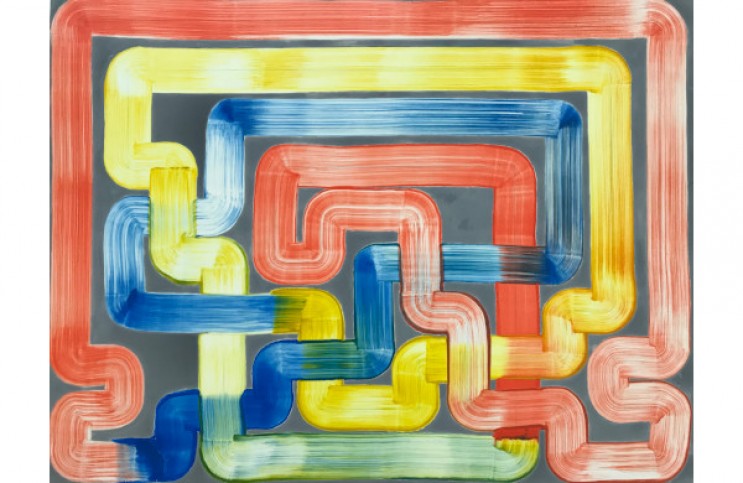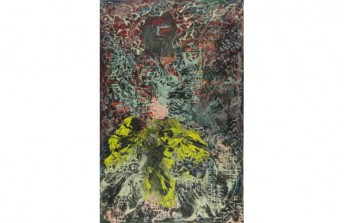Bernard Frize, Without Remorse at Centre Pompidou
Jun 24, 2019
Bernard Frize has returned to Paris this summer for his first major exhibitions there in 15 years. Bernard Frize—Without Remorse is on view until 26 August at the Centre Pompidou, and Bernard Frize—Now Or Never runs concurrently through 14 August at Perrotin gallery. The Perrotin exhibition is smaller, consisting of newer works made in the past few years. The Pompidou exhibition, meanwhile, examines his entire career up to this point—40-plus years worth of paintings. Frize is easily amongst the most discussed French abstract artists today, but the conversations we have about his work tend to always raise more questions than they answer. This is a good thing. Questions are essential to what Frize does. He asks, “How will I paint the next painting?” Then when we see what he has done, we ask, “How did he paint that painting?” Over and over again the questions are asked: how will I do it, and how did he do it? The mystery within his processes never ends. And yes, as is often pointed out, process is a major part of his work. Frize limits his choices by establishing certain rules and structures for each new series he embarks upon. Those self-imposed limitations free him to experiment. But Frize is not what we would call a Process Artist. To a true Process Artist, the end product—the art object—is not the main focus. Instead, the process of creation—the creative act—is all that matters. To Frize, however, I would argue that the end product is absolutely critical. It is the proof of his methods; evidence of his questions and the answer to his questions; it is the validation of one failure and the sign post pointing to the next possibility.
A Serial Seeker
Bernard Frize—Without Remorse features more than 70 works, with the earliest dating back to 1976. The exhibition is designed to offer a fresh take on an oeuvre dominated by methodical series by introducing randomness and whimsy to the curatorial process. The exhibition space was divided into six segments. Viewed from above, the walls form a grid, which is the fundamental compositional structure Frize tends to work with. The names given to the gallery segments are With Unreason, Without Effort, With System, Without System, With Mastery, Without Stopping. Viewers can meander through the segments at will. In each new area they will find writings by Frize about the work. Rather than hanging the paintings thematically or by date according to the series in which they were created, however, as is most often done with this work, works from each of the various series were scattered throughout the different galleries. This randomized curation allows viewers to encounter examples of the different series in different contexts, thus perhaps enabling new conclusions to arise. Exhibition curator Angele Lampe writes in the catalogue, “These constraints gave us the freedom to rearrange [the] work without too much gravitas.”

Bernard Frize - Frappant, 2005. 100 x 100 cm. Foam, polyester, forex, etc. Private collection. © Bernard Frize/Adagp, Paris 2019. Exhibition view. Photo by: IdeelArt.
Seriousness is often the death knoll for abstract art. How often are we alienated or confused by a work, or told by an artist or critic that our interpretation is wrong? Conversely, how often is an abstract work or the artist who made it completely dismissed because of a perceived lack of seriousness? Frize has been toeing that line his entire career. On one hand, he takes a relaxed approach, insisting that his paintings are not about anything in particular. He leaves their interpretation entirely up to the viewer. Even their titles are random (regardless of whatever associations a viewer might sense they have with whatever content might be present in the work). On the other hand, he knows that the relationship between the painting and the viewer is quite serious indeed. Within that relationship is where the natural value of art manifests. Thus, without being too serious, Frize strives seriously to make pictures that are worth our consideration. He seeks out newness in every painting so we will be rewarded with surprise when we look.

Bernard Frize - Oma, 2007. Acrylic on canvas. 240.5 x 310 cm. Centre Pompidou, Musée national d’art moderne, Paris. © Bernard Frize/Adagp, Paris 2019. Exhibition view. Photo by: IdeelArt.
Systems of Chance
A key point Frize often makes about his method is that chance is important. Even though he initiates every new series by establishing a set of rules for it, he only does so as a way to get started. The structure gives him a space in which to intuit, and he embraces the accidents that arise while he is working. He has talked, for example, about letting one painting drip onto the next so the random drips can offer him a fresh starting point, or about letting the failures of one composition inspire the beginning of the next one. The most rewarding thing about the curation of Bernard Frize—Without Remorse is how it also maximizes chance. If we were to look at these works in order that they were made, we would concern ourselves entirely with admiring the evolution of each series. By scattering them about randomly, the curation sets us free from that constraint.

Bernard Frize - Without Remorse at the Center Pompidou, exhibition view. © Bernard Frize/Adagp, Paris 2019. Photo by: IdeelArt.
Paradoxically, however, when we do encounter a work from a series that we also encountered once before, we are reminded that Frize works in series. That revelation occurs frequently in Without Remorse, making one feel that, after all, this really is an exhibition about structure. Yet along the way it never holds structure up as an unassailable monument. Quite the opposite. It shows us how structures have a lifespan, and are only as valuable as the creative acts they spawn. Frize may be right in his thinking that it is impossible to infuse absolute meaning and intent into an abstract painting. But there is something ever human about his absurdist gestures, random methodology, and self-fulfilling processes. That human element is worth looking for in these canvases. It may be why, even when the work fails, or seems to be without any meaning at all, the artist should have no remorse.
Featured image: Bernard Frize - Perma, 2006. Acrylic and resin on canvas. 132 x 174 cm. Courtesy Galerie Perrotin & Bernard Frize. © Bernard Frize/Adagp, Paris 2019. Exhibition view. Photo by: IdeelArt.
All images used for illustrative purposes only
By Phillip Barcio






